A Numerical Study of the Vibration Characteristics of a Haptic Actuator for a Dial Gear Shifter
Abstract
:Featured Application
Abstract
1. Introduction
2. Materials and Methods
2.1. Structure of the Haptic Actuator
2.2. Finite Element Analysis for Transducer Design
2.3. Electromagnetic Field Analysis of Haptic Actuator
2.4. Simulation for the Haptic Actuator
2.5. Vibration Tests of the Haptic Actuator
2.6. Numerical Model of the Dial Gear Shifter
3. Results and Discussion
3.1. Characterization of the Haptic Actuator
3.2. Vibration Responses and Sensitivity Analysis
3.3. Optimized Design of the Numerical Model
3.4. Discussion
4. Conclusions
Author Contributions
Funding
Institutional Review Board Statement
Informed Consent Statement
Data Availability Statement
Acknowledgments
Conflicts of Interest
References
- Mourtzis, D.; Angelopoulos, J.; Panopoulos, N. The future of the human–machine interface (HMI) in society 5.0. Future Internet 2023, 15, 162. [Google Scholar] [CrossRef]
- Bengler, K.; Rettenmaier, M.; Fritz, N.; Feierle, A. From HMI to HMIs: Towards an HMI framework for automated driving. Information 2020, 11, 61. [Google Scholar] [CrossRef]
- Naujoks, F.; Hergeth, S.; Wiedemann, K.; Schömig, N.; Forster, Y.; Keinath, A. Test procedure for evaluating the human–machine interface of vehicles with automated driving systems. Traffic Inj. Prev. 2019, 20, 146–151. [Google Scholar] [CrossRef]
- Jansen, B.J. The graphical user interface. ACM SIGCHI Bull. 1998, 30, 22–26. [Google Scholar] [CrossRef]
- Walch, M.; Lange, K.; Baumann, M.; Weber, M. Autonomous driving: Investigating the feasibility of car-driver handover assistance. In Proceedings of the 7th International Conference on Automotive User Interfaces and Interactive Vehicular Applications, Nottingham, UK, 1–3 September 2015. [Google Scholar]
- Cornelio, P.; Velasco, C.; Obrist, M. Multisensory integration as per technological advances: A review. Front. Neurosci. 2021, 15, 652611. [Google Scholar] [CrossRef]
- Albustanji, R.N.; Elmanaseer, S.; Alkhatib, A.A. Robotics: Five senses plus one—An overview. Robotics 2023, 12, 68. [Google Scholar] [CrossRef]
- Maggioni, E.; Cobden, R.; Dmitrenko, D.; Hornbæk, K.; Obrist, M. SMELL SPACE: Mapping out the olfactory design space for novel interactions. ACM Trans. Comput. Hum. Interact. 2020, 27, 1–26. [Google Scholar] [CrossRef]
- Ratcliffe, M. Touch and situatedness. Int. J. Philos. Stud. 2008, 16, 299–322. [Google Scholar] [CrossRef]
- Maereg, A.T.; Nagar, A.; Reid, D.; Secco, E.L. Wearable vibrotactile haptic device for stiffness discrimination during virtual interactions. Front. Robot. AI 2017, 4, 42. [Google Scholar] [CrossRef]
- Katzschmann, R.K.; Araki, B.; Rus, D. Safe local navigation for visually impaired users with a time-of-flight and haptic feedback device. IEEE Trans. Neural Syst. Rehabil. Eng. 2018, 26, 583–593. [Google Scholar] [CrossRef]
- Balachandran, A.; Brown, M.; Erlien, S.M.; Gerdes, J.C. Predictive haptic feedback for obstacle avoidance based on model predictive control. IEEE Trans. Autom. Sci. Eng. 2015, 13, 26–31. [Google Scholar] [CrossRef]
- Chang, W.; Hwang, W.; Ji, Y.G. Haptic seat interfaces for driver information and warning systems. Int. J. Hum.-Comput. Int. 2011, 27, 1119–1132. [Google Scholar] [CrossRef]
- Petermeijer, S.M.; Abbink, D.A.; Mulder, M.; De Winter, J.C. The effect of haptic support systems on driver performance: A literature survey. IEEE Trans. Haptics 2015, 8, 467–479. [Google Scholar] [CrossRef]
- Chun, J.; Han, S.H.; Park, G.; Seo, J.; Choi, S. Evaluation of vibrotactile feedback for forward collision warning on the steering wheel and seatbelt. Int. J. Ind. Ergon. 2012, 42, 443–448. [Google Scholar] [CrossRef]
- Wang, Z.; Zheng, R.; Kaizuka, T.; Shimono, K.; Nakano, K. The effect of a haptic guidance steering system on fatigue-related driver behavior. IEEE Trans. Hum.-Mach. Syst. 2017, 47, 741–748. [Google Scholar] [CrossRef]
- Gaffary, Y.; Lécuyer, A. The use of haptic and tactile information in the car to improve driving safety: A review of current technologies. Front. ICT 2018, 5, 5. [Google Scholar] [CrossRef]
- Beruscha, F.; Krautter, W.; Lahmer, A.; Pauly, M. An evaluation of the influence of haptic feedback on gaze behavior during in-car interaction with touch screens. In Proceedings of the IEEE World Haptics Conference, Munich, Germany, 6–9 June 2017. [Google Scholar]
- Hirokawa, M.; Uesugi, N.; Furugori, S.; Kitagawa, T.; Suzuki, K. Effect of haptic assistance on learning vehicle reverse parking skills. IEEE Trans. Haptics 2014, 7, 334–344. [Google Scholar] [CrossRef] [PubMed]
- Hwang, S.; Ryu, J.H. The haptic steering wheel: Vibro-tactile based navigation for the driving environment. In Proceedings of the 8th IEEE International Conference on Pervasive Computing and Communications Workshops, Mannheim, Germany, 29 March–2 April 2010. [Google Scholar]
- De Rosario, H.; Louredo, M.; Díaz, I.; Soler, A.; Gil, J.J.; Solaz, J.S.; Jornet, J. Efficacy and feeling of a vibrotactile Frontal Collision Warning implemented in a haptic pedal. Transp. Res. F Traffic Psychol. Behav. 2010, 13, 80–91. [Google Scholar] [CrossRef]
- De Nijs, S.Y.; Mulder, M.; Abbink, D.A. The value of haptic feedback in lane keeping. In Proceedings of the IEEE International Conference on Systems, Man, and Cybernetics, San Diego, CA, USA, 5–8 October 2014. [Google Scholar]
- Shakeri, G.; Brewster, S.A.; Williamson, J.; Ng, A. Evaluating haptic feedback on a steering wheel in a simulated driving scenario. In Proceedings of the CHI Conference Extended Abstracts on Human Factors in Computing Systems, San Jose, CA, USA, 7–12 May 2016. [Google Scholar]
- Fitch, G.M.; Hankey, J.M.; Kleiner, B.M.; Dingus, T.A. Driver comprehension of multiple haptic seat alerts intended for use in an integrated collision avoidance system. Transp. Res. F Traffic Psychol. Behav. 2011, 14, 278–290. [Google Scholar] [CrossRef]
- Breitschaft, S.J.; Pastukhov, A.; Carbon, C.C. Where’s my button? Evaluating the user experience of surface haptics in featureless automotive user interfaces. IEEE Trans. Haptics 2021, 15, 292–303. [Google Scholar] [CrossRef]
- Abbink, D.A.; Mulder, M.; Van der Helm, F.C.; Mulder, M.; Boer, E.R. Measuring neuromuscular control dynamics during car following with continuous haptic feedback. IEEE Trans. Syst. Man. Cybern. B Cybern. 2011, 41, 1239–1249. [Google Scholar] [CrossRef]
- Xu, X.; Dong, P.; Liu, Y.; Zhang, H. Progress in automotive transmission technology. Automot. Innov. 2018, 1, 187–210. [Google Scholar] [CrossRef]
- Pyo, D.; Yang, T.H.; Ryu, S.; Kwon, D.S. Novel linear impact-resonant actuator for mobile applications. Sens. Actuators A Phys. 2015, 233, 460–471. [Google Scholar] [CrossRef]
- Jackson, J.D. Classical Electrodynamics, 3rd ed.; Wiley: Hoboken, NJ, USA, 1999; pp. 237–242. [Google Scholar]
- Karna, S.K.; Sahai, R. An overview on Taguchi method. Int. J. Math. Sci. 2012, 1, 1–7. [Google Scholar]
- Howe, R.D.; Cutkosky, M.R. Sensing skin acceleration for slip and texture perception. In Proceedings of the ICRA, Scottsdale, AZ, USA, 14–19 May 1989. [Google Scholar]
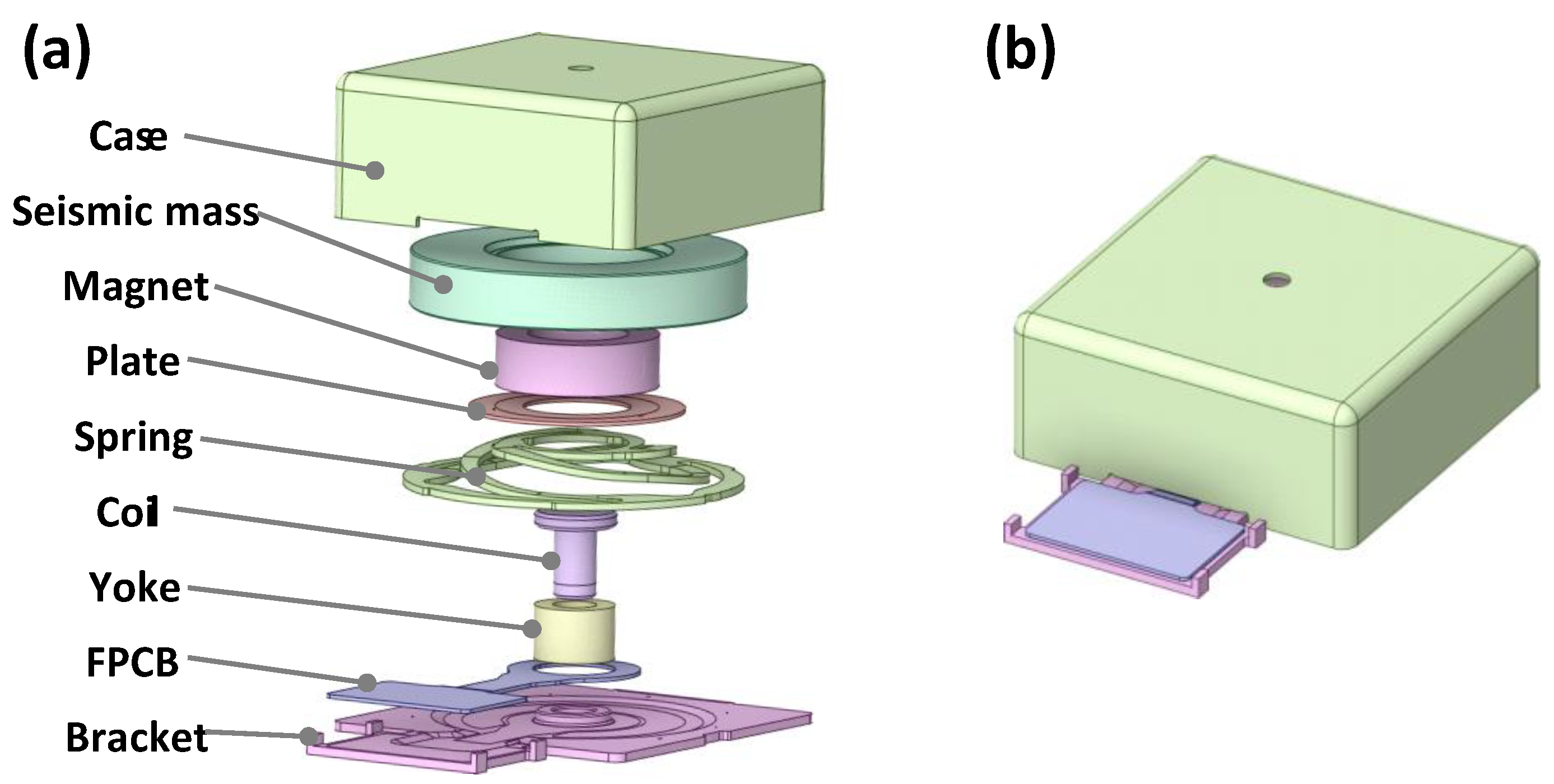

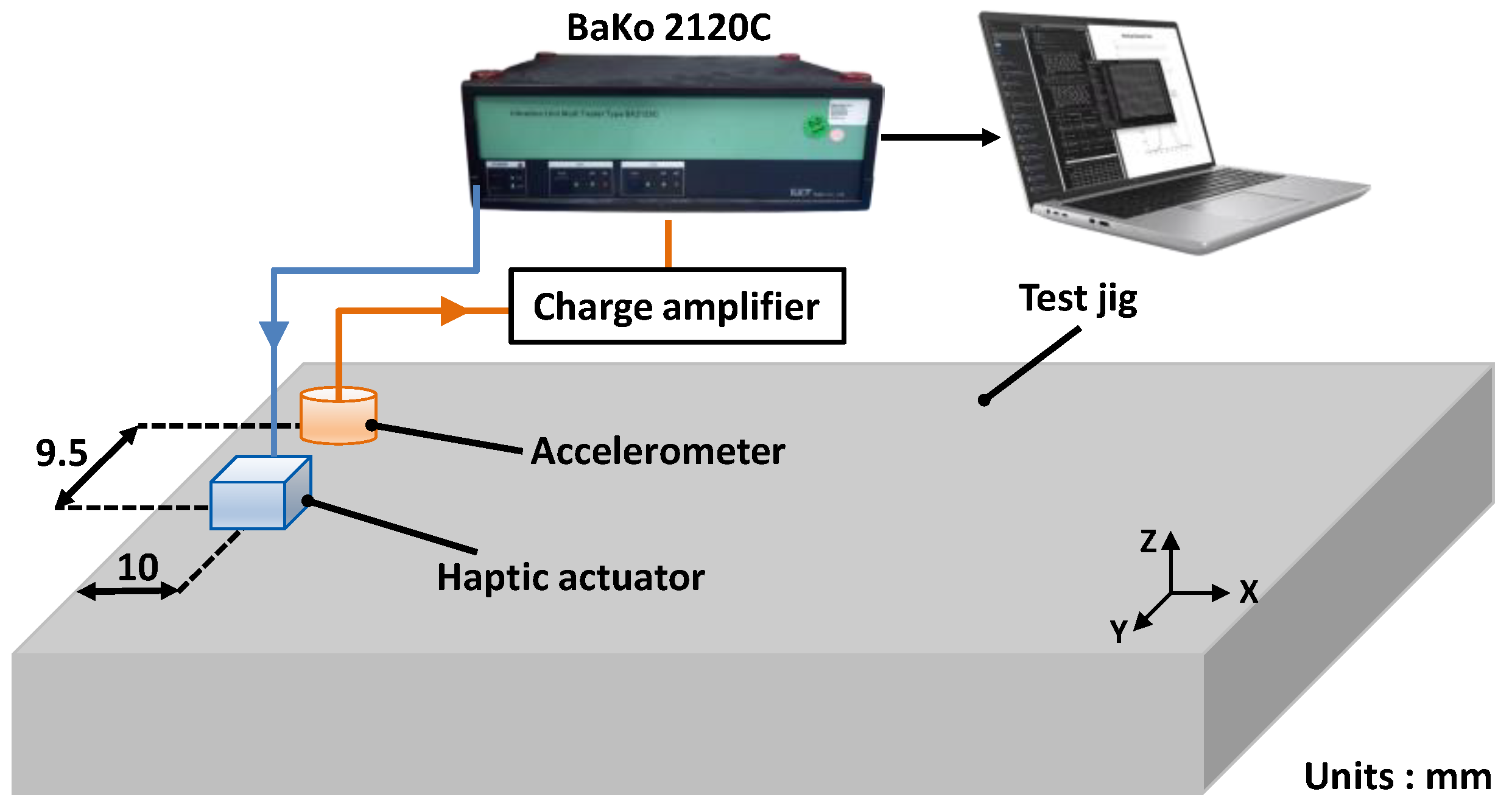

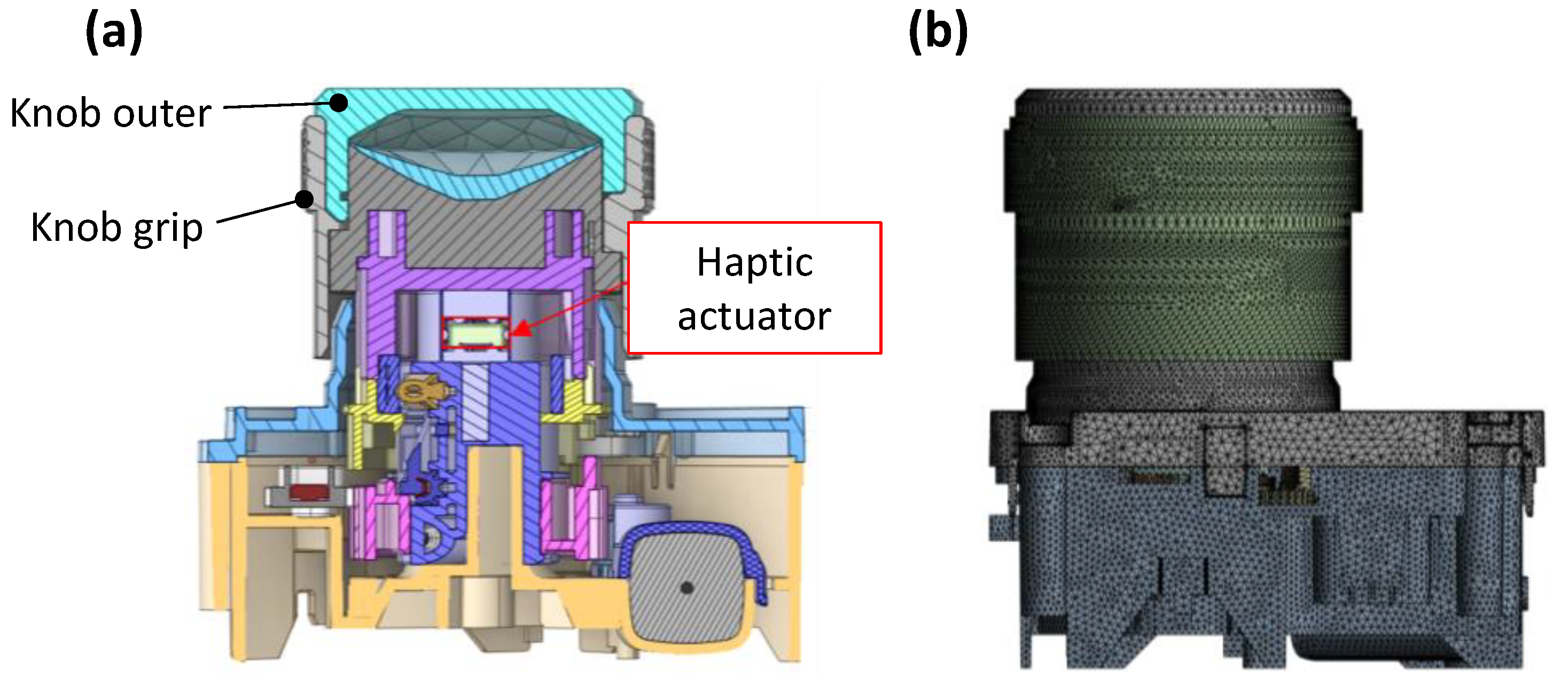



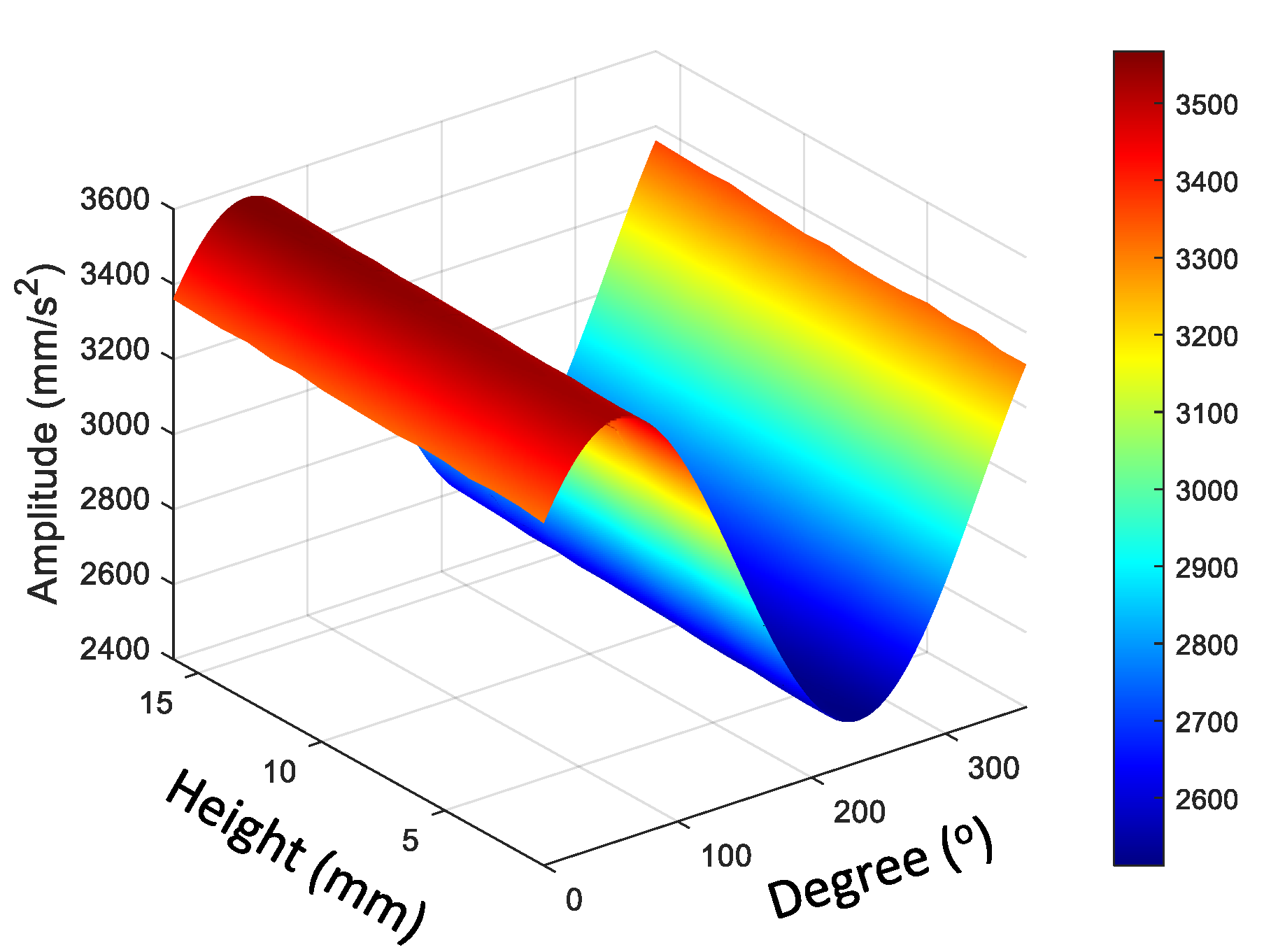


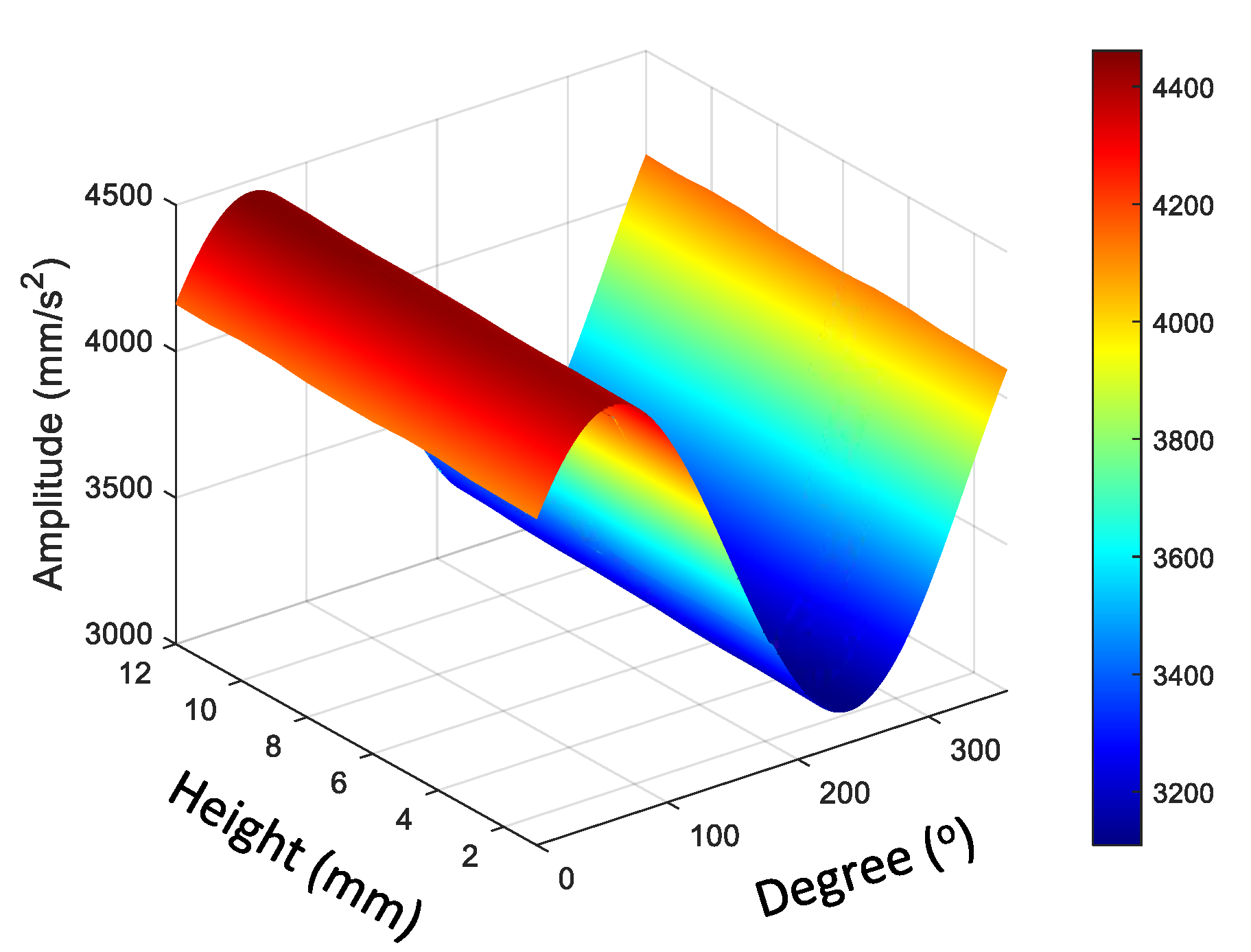
| Inner Diameter (mm) | Outer Diameter (mm) | Number of Turns | Resistance (Ω) | Voltage (V) |
|---|---|---|---|---|
| 1.23 | 2.25 | 186 | 6 | 1 |
| Part | Material | Density (kg/m3) | Young’s Modulus (GPa) | Poisson’s Ratio |
|---|---|---|---|---|
| Bracket Yoke Case | SPCC | 7870 | 200 | 0.23 |
| Spring | SUS301 | 7800 | 190 | 0.3 |
| Weight | Tungsten | 19,500 | 411 | 0.28 |
| Magnet | Nd-Fe-B | 7600 | 150 | 0.24 |
| Jig | Bakelite | 1380 | 7.5 | 0.35 |
| No. | (A) (mm) | (B) (mm) | (C) | (D) |
|---|---|---|---|---|
| 1 | 32 | 17 | 1 | 1 |
| 2 | 32 | 15.5 | 0 | 1 |
| 3 | 32 | 14 | 1 | 1 |
| 4 | 31 | 17 | 0 | 1 |
| 5 | 31 | 15.5 | 1 | 0 |
| 6 | 31 | 14 | 0 | 0 |
| 7 | 30 | 17 | 1 | 1 |
| 8 | 30 | 15.5 | 0 | 0 |
| 9 | 30 | 14 | 1 | 0 |
| No. | Acceleration (mm/s2) | SNR (dB) |
|---|---|---|
| 1 | 3043.2 | 69.667 |
| 2 | 3450.8 | 70.758 |
| 3 | 3399.4 | 70.628 |
| 4 | 3322.9 | 70.430 |
| 5 | 3251.5 | 70.242 |
| 6 | 3698.0 | 71.359 |
| 7 | 3131.8 | 69.916 |
| 8 | 3519.4 | 70.929 |
| 9 | 3436.0 | 70.721 |
Disclaimer/Publisher’s Note: The statements, opinions and data contained in all publications are solely those of the individual author(s) and contributor(s) and not of MDPI and/or the editor(s). MDPI and/or the editor(s) disclaim responsibility for any injury to people or property resulting from any ideas, methods, instructions or products referred to in the content. |
© 2024 by the authors. Licensee MDPI, Basel, Switzerland. This article is an open access article distributed under the terms and conditions of the Creative Commons Attribution (CC BY) license (https://creativecommons.org/licenses/by/4.0/).
Share and Cite
Won, J.; Ko, K.; Eom, H.; Kim, C.; Cho, J.; Kim, H. A Numerical Study of the Vibration Characteristics of a Haptic Actuator for a Dial Gear Shifter. Appl. Sci. 2024, 14, 9242. https://doi.org/10.3390/app14209242
Won J, Ko K, Eom H, Kim C, Cho J, Kim H. A Numerical Study of the Vibration Characteristics of a Haptic Actuator for a Dial Gear Shifter. Applied Sciences. 2024; 14(20):9242. https://doi.org/10.3390/app14209242
Chicago/Turabian StyleWon, Joonsik, Kinyeong Ko, Heesoo Eom, Chulsook Kim, Jihyun Cho, and Howuk Kim. 2024. "A Numerical Study of the Vibration Characteristics of a Haptic Actuator for a Dial Gear Shifter" Applied Sciences 14, no. 20: 9242. https://doi.org/10.3390/app14209242






